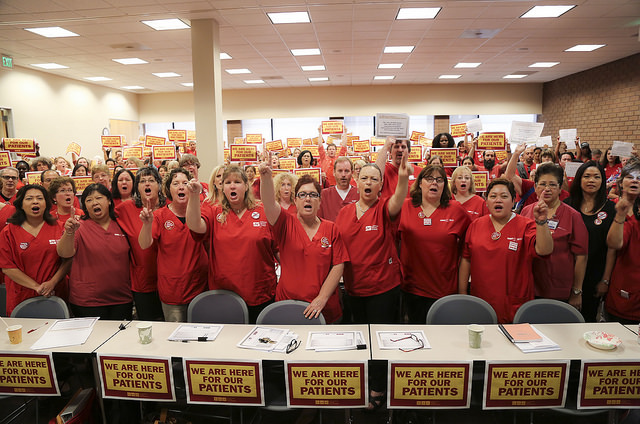Press Release
Kaiser Still Avoiding Contract Talks with RNs As Nurses Outline Widespread Patient Care Concerns

With Kaiser Permanente registered nurses stepping up their alarm about the erosion of patient care standards, Kaiser officials Thursday once again failed to attend a planned collective bargaining session with RN nurse negotiators.
Kaiser refused to join talks today even though the RNs went to a site for negotiations, at an Oakland hotel, that Kaiser had proposed, the California Nurses Association, National Nurses United, which represents 18,000 Kaiser RNs at 21 hospitals and 66 clinics announced.
Today’s absence marks the third straight week that Kaiser officials have put off or failed to attend negotiations, a step the RNs charge is driven by Kaiser’s desire to avoid addressing the RNs’ widespread concerns about erosion of care standards.
“Kaiser has sought to impose how the talks should proceed, even when we have offered to change past practice and meet in what they say they want in a supposed neutral environment. What is really occurring is that Kaiser is trying to avoid confronting what is occurring every day in their hospitals, and the need to have solutions to protect their patients,” said CNA Co-president Zenei Cortez, RN, chair of the Kaiser RN bargaining team.
In the interim, Kaiser RNs have presented many of the ways patient care is under attack, and are inviting Kaiser members to send their stories, emailed to patientcare@calnurses.org.
Bargaining was set to begin Thursday, July 24, but Kaiser postponed talks. Negotiations were then scheduled for Thursday, July 31, but Kaiser officials refused to attend the meeting planned at CNA headquarters, even though the parties have alternated meetings for years between CNA and Kaiser offices.
CNA then offered to meet today at a “neutral” Oakland church, which Kaiser rejected, and then at an Oakland hotel that Kaiser has previously proposed. The conference room at the hotel was set up for the talks. Kaiser again refused to participate.
“We have been ready since day one to move forward,” said Cortez. “It’s time for Kaiser to stop putting forward artificial obstacles so we can talk about patient safety and the growing erosion of patient care standards.”
With formal talks in abeyance, Kaiser RNs have outlined sweeping patient care issues, presented in communications with Kaiser managers, emphasizing that “Kaiser’s model of care fails our patients.”
- In the ER, patients who used to be admitted for monitoring are now being discharged and sent home to follow up in a clinic, even when it can lead to harm for patients.
- Many patients are held for 23 hours in the ER rather than admitted when they need hospital care.
- More patients are suffering as they lay on gurneys for hours in hallways while waiting for a proper hospital bed. Gurneys are often not wide enough leaving patients, especially the elderly, feeling unsafe on them.
- Patients in the hospital are many times placed in the wrong area for care, for example, housed in a general medical-surgical unit when they require intensive care.
- Many patients are downgraded prematurely before they are medically ready. Kaiser prefers a lower level of staffed care rather than units where patients are more closely monitored.
- More patients are being held in outpatient observation status, even when in a hospital bed. Failure to categorize patients as “admitted” can lead the patients to having to pay far more in out-of-pocket costs if transferred to a nursing home.
- Labor and delivery units are chronically understaffed. Pregnant women are often forced to wait in other units while there are not enough RNs to help deliver their babies.
- In surgical departments, Kaiser’s model prioritizes speed over safety, even occasionally leading to retained foreign objects and wrong site surgeries.
- Too many patients are sent home too soon without adequate discharge teaching. Patients and family members struggle with drainage tubes when they should be in the hospital under the care of an RN.
- Kaiser has closed urgent care clinics, cut evening and weekend hours and forced patients to go to the emergency room where they pay high co-pays when no appointments are available.
- In the clinics, nurse practitioners have less time and patients are rushed even though they are often sicker.
- In the call centers, calls are handled by non-RNs following pre-written scripts. Patients frequently are refused the opportunity to speak to an RN and sent to the wrong level of care. The volume of calls and severity of illnesses presented in calls has spiked dramatically due to the early, premature discharge of patients from Kaiser hospitals.
- Patient service closures are increasing. The closure of the pediatric unit in Hayward for 277,000 Southern Alameda County patients occurred over the protests of nurses and community residents. Widespread cuts at Manteca for 80,000 patients have meant long waits for care.
These problems have occurred as Kaiser profits for the first quarter of 2014 jumped to $1.1 billion, a 44 percent increase over the same quarter last year. Its operating revenues were up 6 percent and operating profits up 49 percent during the same period. Last year, Kaiser made $2.7 billion in profits.
Additionally, Kaiser has accumulated a $21.7 billion reserve fund, 1,626 percent more than required by the state, a clear indication on top of the nearly $4 billion in profits the past 15 months that cuts in care are unnecessary, says CNA.